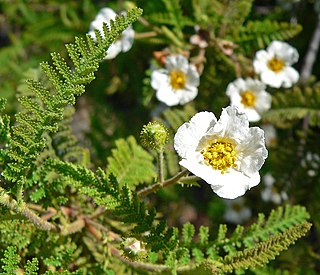Related Research Articles

Acidobacteria is a phylum of bacteria. Its members are physiologically diverse and ubiquitous, especially in soils, but are under-represented in culture.

Chamaebatia, also known as mountain misery, is a genus of two species of aromatic evergreen shrubs endemic to California. Its English common name derives from early settlers' experience with the plant's dense tangle and sticky, strong-smelling resin. They are actinorhizal, non-legumes capable of nitrogen fixation through symbiosis with actinobacteria Frankia.

Bradyrhizobium is a genus of Gram-negative soil bacteria, many of which fix nitrogen. Nitrogen fixation is an important part of the nitrogen cycle. Plants cannot use atmospheric nitrogen (N2); they must use nitrogen compounds such as nitrates.
Pararhizobium giardinii is a Gram negative root nodule bacteria. It forms nitrogen-fixing root nodules on legumes, being first isolated from those of Phaseolus vulgaris.
Rhizobium gallicum is a Gram-negative root-nodule bacterium. It forms nitrogen-fixing root nodules on legumes, being first isolated from those of Phaseolus vulgaris.
Bradyrhizobium arachidis is a species of legume-root nodulating, microsymbiotic nitrogen-fixing bacterium. It was first isolated from Arachis hypogaea root nodules in China. Its type strain is CCBAU 051107T.
Bradyrhizobium liaoningense is a species of legume-root nodulating, microsymbiotic nitrogen-fixing bacterium. It was first isolated from Glycine soja and Glycine max root nodules in China. Its type strain is strain 2281.
Azoarcus tolulyticus is a species of bacteria. It is a nitrogen-fixing bacteria. It is notable for degrading toluene. Tol-4 is its type strain.
Vibrio coralliilyticus is a Gram-negative, rod-shaped bacterium. It has a polar flagellum that is used for motility and has been shown to be critical for its virulence to corals. It is a versatile pathogen, impacting several marine invertebrates including Pocillopora damicornis corals, both the Pacific and Eastern Oyster’s larvae and some vertebrates such as the Rainbow Trout. It is a bacterium of considerable interest given its direct contribution to temperature dependent coral bleaching as well as its impacts on aquaculture where it can contribute to significant mortalities in larval oyster hatcheries. There are several known virulent strains, which appear on both the Pacific and Atlantic Coasts of the United States. After its initial discovery some strains were incorrectly classified as Vibrio tubiashii including the RE22 and RE98 strains but were later reclassified as Vibrio coralliilyticus.
Leptospirillum ferriphilum is an iron-oxidising bacterium. It is one of the species responsible for the generation of acid mine drainage. It is of particular relevance in South African commercial biooxidation tanks operating at 40 °C.
Bradyrhizobium canariense is a species of legume-root nodulating, endosymbiont nitrogen-fixing bacterium. It is acid-tolerant and nodulates endemic genistoid legumes from the Canary Islands. The type strain is BTA-1T.
Mesorhizobium plurifarium is a species of root nodule bacteria first isolated from Acacia species in Senegal. Its type strain is ORS 1032.
Methanolobus profundi is a mesophilic, methylotrophic methanogen archaeon. The type strain is MobMT. It was isolated from a deep subsurface gas field.
Bradyrhizobium yuanmingense is a species of legume-root nodulating, endosymbiont nitrogen-fixing bacterium, associated with Lespedeza and Vigna species. Its type species is CCBAU 10071(T).
Pelobacter carbinolicus is a species of bacteria that ferments 2,3-butanediol and acetoin. It is Gram-negative, strictly anaerobic and non-spore-forming. Gra Bd 1 is the type strain. Its genome has been sequenced.
Leuconostoc carnosum is a lactic acid bacterium; its type strain is NCFB 2776. Its genome has been sequenced. Its name derives from the fact that it was first isolated from chill-stored meats. Its significance is that it thrives in anaerobic environments with a temperature around 2 °C, thus has been known to spoil vacuum-packed meat, yet it is not pathogenic and certain strains of L. carnosum are known to produce bactericides known to inhibit or kill Listeria monocytogenes.
Helicobacter canadensis is a bacterium in the Helicobacteraceae family, Campylobacterales order, first isolated from humans with diarrhea. Its genome has been sequenced.
Bradyrhizobium betae is a species of legume-root nodulating, microsymbiotic nitrogen-fixing bacterium first isolated from the roots of Beta vulgaris, hence its name. It is slow-growing an endophytic. The type strain is PL7HG1T.
Rhizobium lusitanum is a Gram negative root nodule bacteria, specifically nodulating Phaseolus vulgaris. Its type strain is P1-7T.
Chloroflexus aggregans is a thermophilic, filamentous, phototrophic bacterium that forms dense cell aggregates. Its type strain is strain MD-66.
References
- ↑ Islam MS, Kawasaki H, Muramatsu Y, Nakagawa Y, Seki T (June 2008). "Bradyrhizobium iriomotense sp. nov., isolated from a tumor-like root of the legume Entada koshunensis from Iriomote Island in Japan". Bioscience, Biotechnology, and Biochemistry . 72 (6): 1416–29. doi: 10.1271/bbb.70739 . PMID 18540091 . Retrieved 2013-09-08.